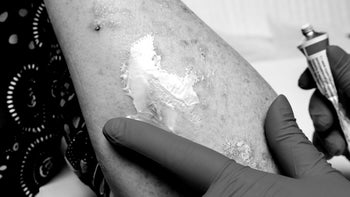
How to Get a Splinter Out: 8 Methods to Try at Home
Key takeaways:
A splinter is a small, foreign object (like a sliver of wood) that gets partly or completely embedded in the skin.
It’s a good idea to remove a splinter the day you find it. This helps prevent infection.
Getting a splinter out can be straightforward. You can get most splinters out using tools you have at home, like tweezers, baking soda, and duct tape.
Table of contents

Getting a splinter is a literal pain. Who knew that something so small could cause such discomfort? Your body knows something isn’t right and just keeps sending you a little pain signal that won’t stop until you get that splinter out.
Any foreign object that gets lodged into your skin can be considered a splinter. Most splinters are small pieces of wood. But you can also get a splinter from glass, plastic, or metal.
The good news is getting a splinter out can be done at home. With just simple tools and the proper techniques, you’ll be ready next time you accidentally get a splinter.
Search and compare options
What should you do after you get a splinter?
If you get a splinter, the first thing you want to do is wash your skin with soap and water. This will help get rid of bacteria and lower the risk of infection.
Then take a good look at the splinter. A magnifying glass or magnifying app on your phone can help with this step.
Take note of:
Depth: Check whether any part of the splinter is sticking out of your skin. This is where you want to grasp it when it’s time to get the splinter out. If no part is sticking out, see if it looks close to the skin’s surface. If it is, or you can easily feel it, then you’ll have good luck getting it out at home.
Direction: Check the direction of your splinter. Is it horizontal or vertical inside your skin? See if you can tell the angle at which it entered your skin. When you pull your splinter out, you want to move in the same direction.
Finally, find help if you can. Getting a splinter out on your own isn’t always easy, especially if the splinter is in the finger of your dominant hand. Splinter removal can be quicker and easier if you have an extra set of hands to help out.
How to remove a splinter
Once you’re ready, here are eight things that can help with splinter removal.
1. Tweezers
A pair of tweezers is all you need to get a superficial splinter out, especially if part of it is sticking out of your skin. First, sterilize your tweezers by cleaning them with 70% rubbing alcohol. Let the tweezers dry completely before using them.
Avoid infection: Usually, the wound from a splinter heals quickly. But if it becomes more painful, red, or swollen over time, it could be infected. Find out how to clean your wound properly once the splinter is removed — and how to treat an infected cut.
Are antibiotic ointments necessary? Learn about the best antibiotic ointments and when it’s better to skip the treatment.
First-aid must haves: It’s a good idea to keep a pair of tweezers for splinters and ticks. Read about other expert-recommended items to keep in your first aid kit.
Next, grasp the end of the splinter with your tweezers (use a magnifying glass if you can’t see it well). Gently pull the splinter out in the same direction it entered the skin. Try not to squeeze the splinter or the skin around it. The pressure can make the splinter break into smaller pieces, making it harder to remove.
2. Needles
If your splinter is completely embedded in your skin, you can use a small needle to help remove it. First, sterilize your needle by dipping it in 70% rubbing alcohol. Let the needle dry completely before using it.
Next, pierce your skin right underneath one end of the splinter. Slowly coax that end out of your skin. Once part of the splinter is sticking out, use tweezers to pull it the rest of the way out.
Read more like this
Explore these related articles, suggested for readers like you.
3. Duct tape
If you don’t have anyone to help or if tweezers and needles make you a bit nervous — you can try duct tape to remove your splinter. Take a piece of duct tape and cover your splinter. Leave the tape on for 30 minutes, then slowly remove it in the opposite direction the splinter entered the skin.
This trick works best if your splinter is near the surface of your skin or if part of it is already sticking out.
4. Baking soda paste
If your splinter is embedded a bit deeper (but you can still feel it), you might have trouble reaching it with a needle. You’ll want to bring it closer to the surface before you try to get it out. Baking soda paste may help.
Mix 1 tablespoon of baking soda and 1 tablespoon of water. Apply the paste around the skin at the site of the splinter. Cover it with a bandage and leave it on for 24 hours. After 24 hours, the splinter may be closer to the surface of your skin, so you can try removing it with a needle and/or tweezers.
5. Epsom salts
Epsom salts can be great for sore muscle relief — but did you know they might also help with splinters? Like baking soda, Epsom salts may bring a splinter closer to the surface of your skin.
Dissolve a cup of Epsom salt into a warm bath and soak your skin for 30 minutes. Once you’ve dried off, use your needle and/or tweezers to pull the splinter out.
6. Hydrogen peroxide
Mix one part hydrogen peroxide with one part water. Pour the mixture over your splinter. Within a few minutes your splinter might come closer to the surface of your skin. Some people have good luck using a white vinegar solution. Both options may cause stinging and irritation to your skin.
7. Wax strips
At home wax strips can help with getting a splinter out. It’s best to use this option for plant splinters like tiny cactus needles or for very thin splinters where one end is sticking out of your skin.
It can be tricky to decide how to pull the wax strip. You want to pull in the opposite direction that the splinter entered the skin. Follow the package directions for instructions on how to heat wax and how long to wait before removing with the strip.
8. Potatoes and banana peels
While there’s no data to support this, the theory is that the enzymes in potato and banana peels can make the skin softer. This makes it easier to get a splinter out using a needle and/or tweezers.
You have to keep the peel on for several hours — which can be tough to do since peels are pretty slippery. There’s also a risk that these items can have bacteria on them and increase the risk for infection.
How to draw out a deep splinter you can’t see
Don’t try to draw out a deep splinter that you can’t see at home. Poking randomly into your skin with needles and tweezers will cause damage to your healthy tissue and can lead to injury and long-term scarring. Also each poke increases your risk for developing infection.
Get help if you feel a splinter but can’t see it. Your primary care professional or local urgent care center can help remove the unseen splinter or connect you with a surgeon. They can also get an X-ray or ultrasound to locate your splinter.
What should I do after I get a splinter out?
Once your splinter is out — clean the area again with soap and water. You can put antibiotic ointment on your wound and cover it with a bandage. Change your bandage anytime it gets wet or dirty.
Do splinters come out on their own?
Will a splinter come out on its own? It can, but not always. A foreign object will trigger an immune response where immune cells travel to the area, which sometimes can push the splinter out. But it’s important not to leave certain items in and wait for your immune system to do the work. Natural materials, like wood and plant material, need to come out right away. They can lead to infection.
What happens to splinters that don’t come out?
It depends. A very small, thin splinter may eventually work its way to the surface of your skin. You’ll then be able to pull it out. This can take days to weeks.
But the body won’t naturally “push out” anything bigger. The immune system will attack the splinter. This leads to inflammation, which can damage healthy tissue and cause pain. Eventually the immune system will try to wall off the splinter. This can create a bump that you may be able to feel under your skin.
A bump and pain might not sound like a big deal. But the bigger problem is that the splinter can introduce bacteria and fungus into your body, which can lead to infection. Your skin naturally protects you from these bugs, but a splinter literally pierces these defenses.
Splinters from wood, plant needles, and thorns are more likely to cause infections. There’s even cases of people getting tetanus from thorn splinters. Splinters from natural materials should come out right away to help avoid infection.
Can splinters be serious?
Splinters are usually just a painful nuisance, but they can be more serious. Depending on the type and location of your splinter, you may need urgent medical attention to avoid problems and serious infection.
You should see a healthcare professional if your splinter is:
Large: A splinter is a very small piece of material. If you have something bigger stuck in your skin — it’s not a splinter and it definitely needs medical attention.
Deep: If the splinter is embedded so deep in your skin that you can’t get it out at home, see a healthcare professional. You’ll need help getting it out so it doesn’t get infected.
Hard to see: If you can’t see your splinter (because it’s glass or plastic) — don’t try to dig it out on your own. You can cause more damage to your skin or introduce bacteria and cause infection.
Near or in your eye: A splinter that’s in your eye or near your eye can lead to permanent vision loss. If you feel like there’s something stuck in your eye, always see an eye doctor right away.
Under a nail: If your splinter is underneath a fingernail or toenail, see a healthcare professional. Don’t try to dig it out yourself. This is difficult and painful, plus you may cause permanent damage to your nail bed.
Bleeding: If the splinter site won’t stop bleeding, get medical help. It might have hit a blood vessel.
Infected: Skin infections can happen around a splinter, especially if you can’t get it out right away. If your splinter site is red, swollen, hot, or painful — you may need treatment for an infection.
You should also touch base with your healthcare professional if you have a splinter and you’re overdue for a tetanus shot.
How do you treat an infected splinter?
Infected splinters need to be treated with antibiotics and splinter removal. You may also need incision and drainage (I&D) if you have an abscess because of your splinter. Get medical care right away if you think you have an infected splinter.
The bottom line
Splinters are tiny, foreign bodies — like pieces of wood — that are partially or completely embedded in the skin. Removing them quickly can prevent infection. Use tweezers if a splinter is sticking out of the skin. A needle may help if it’s completely embedded.
You can also try other home remedies to soften the skin first or to pop the splinter out on its own. But if the splinter is too deep, looks infected, or is in a difficult location, see a healthcare professional for help.
Why trust our experts?


References
American Academy of Dermatology Association. (n.d.). How to remove a splinter.
Australian Government Department of Health and Aged Care. (2023). Identify whether the wound is tetanus-prone. Australian Immunization Handbook.
Chan, C., et al. (2003). Splinter removal. American Family Physician.
Halaas, G. W. (2007). Management of foreign bodies in the skin. American Family Physician.
HealthyChildren.org. (n.d.). Sliver or splinter.
MedlinePlus. (2023). Splinter removal.
NexCare. (n.d.). Splinter strategies.
Schwartz, G. R., et al. (1997). Subungual splinter removal. American Journal of Emergency Medicine.
Seattle Children’s Hospital. (2023). Sliver or splinter.





























